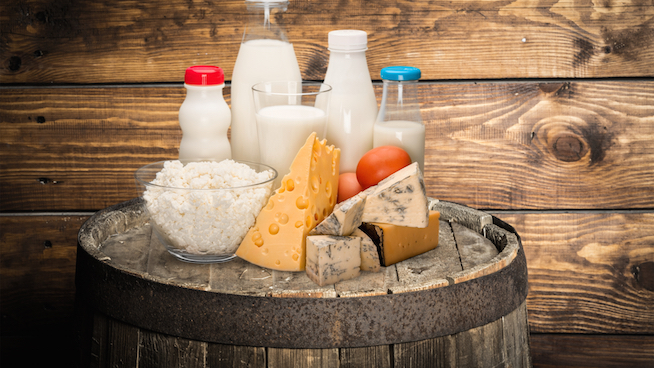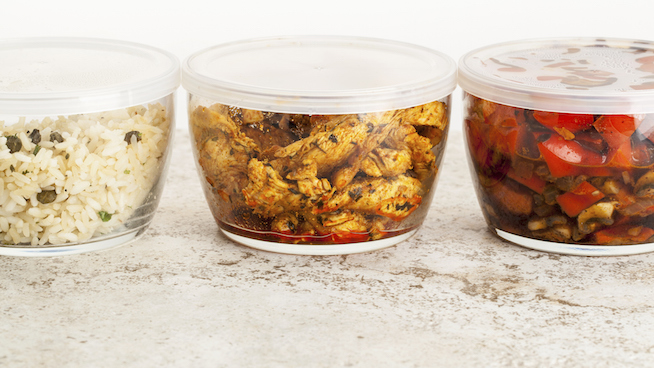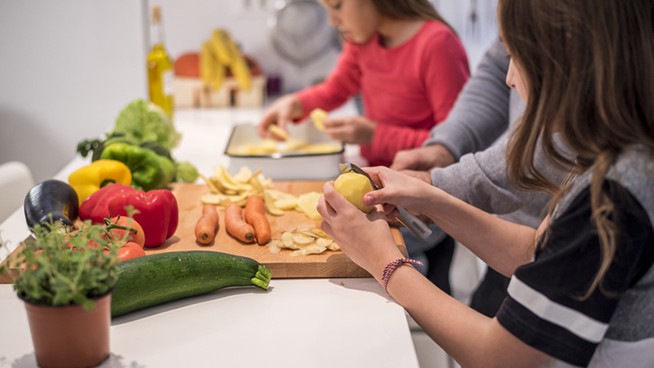This App Boils a Food’s Nutrition Down to a Single Number. Can it Help You Eat Healthier?
Nutrition is all about numbers.
Carbs, calories, fats, micros, macros, daily values, serving sizes—every food carries a dizzying amount of data along with it. For the average American, it can be enough to avoid nutrition facts altogether.
What if instead of every food being labeled with an avalanche of numbers, you could reference a single number that told you what you needed to know? You wouldn’t have to worry about trying to decode the minutiae of nutrition. The one number would be capable of guiding the majority of your food-purchasing choices.
Sounds pretty helpful, right? Well that’s the premise behind the NuVal Nutritional Scoring System. To see if this simplified approach can stick, we dug into the methodology and tested the company’s new smartphone app.
What is the NuVal Nutritional Scoring System?

Photo via the NuVal official website
Simply put, the NuVal Nutritional Scoring System “helps you see—at a glance—the nutrimental value of the food you buy.” NuVal scores each food on a scale of 1 to 100. The higher the score, the better the nutrition.
How can NuVal boil down a food’s nutrition into a single number? It uses an algorithm known as the Overall Nutritional Quality Index (ONQI), which was created in 2007 as a direct response to rapidly rising rates of obesity and diabetes in the American population. While the exact inner workings of the algorithm are patent-pending and unavailable to the public, here’s a briefing on how the ONQI works:
“Developed by a team of leading nutrition, public health, and medical experts, the ONQI algorithm uses the Institute of Medicine’s Dietary Reference Intakes (DRIs – quantitative reference values for recommended intakes of nutrients) and the Dietary Guidelines for Americans (advice from the Department of Health and Human Services and the U.S. Department of Agriculture about how good dietary habits can promote health and reduce risk for major chronic diseases) to quantify the presence of more than 30 nutrients—including vitamins, minerals, fiber, and antioxidants; sugar, salt, trans fat, saturated fat, and cholesterol. The system also incorporates measures for the quality of protein, fat, and carbohydrates, as well as calories and omega-3 fats. The NuVal System also takes into account how these nutrients influence health based on broadly accepted, published scientific literature.”
The aforementioned team of experts was led by Dr. David Katz, director of the Yale-Griffin Prevention Research Center. According to an article written by Dr. Katz for the Huffington Post, the ONQI is “entirely and permanently free of any food industry or political influence.” A 2011 study published in the American Journal of Preventative Medicine concluded that “consumption of foods that lead to a higher score in the ONQI scoring system is associated with modestly lower risk of chronic disease and all-cause mortality.”
RELATED: The New Food Guidelines for Athletes
NuVal is essentially the brand built around the ONQI algorithm. According to the website, the best way to use the NuVal System is to “trade up” from what you’re currently eating to a higher scoring product. “Even the smallest jump in scores can have an impact on your health,” reads an “Expert Tip” on the site. NuVal NuScan—a new app available for both iOS and Android—allows users to scan thousands of different food items with their smartphones and instantly receive their NuVal scores.
How Do I Use the NuVal NuScan App?

Using the NuScan app on my iPhone 6 was ridiculously simple.
Upon opening the app, you’re greeted by a list of your recent scans. From there, you can click on the “scan” button to scan a new item. That’s pretty much all there is to it. The simplicity of the app matches the simplicity of the NuVal score itself.
To scan a food product, all you do is hit the “scan” button and hold the product’s UPC code in front of your camera. Once the code is scanned (signified by a bright green box appearing around the UPC), a panel pops up displaying the product name, UPC number, brand, manufacturer, food category and, most importantly, NuVal score.
As I perused the aisles of my local grocery store scanning at will, I noticed that some niche or local products were not yet in the NuVal database. If you come across a product not yet in the database, you can snap photos of its nutritional info and ingredients and submit them to NuVal for their records. The majority of products already seem to be in database. Roughly 27 of the 30 items I scanned had already been registered.
Fruits and vegetables in their pure forms score high in the NuVal system. I scanned a cucumber, a container of strawberries and a bag of peeled baby carrots. All registered a NuVal score of 100. However, a can of apricot halves in light syrup scored a 30—likely because the syrup adds a bunch of unnecessary sugar. Organic whole milk, black beans and organic bread with flax seed scored 82, 73 and 71, respectively.
RELATED: Is Fat-Free Really Worry Free? The Truth Behind Food Labels
What foods didn’t score so high?
Nutella scored a 2, proving that this “hazelnut spread” should be treated as a dessert. Bark Thins Dark Chocolate Blueberry With Quinoa Crunch, which is described as a “snacking chocolate,” also registered a 2. This is likely due to the fact a 1.4-ounce serving contains 20 grams of sugar and 5 grams of saturated fat. The average consumer could be misled by the cover of the packaging, which includes words like “quinoa,” “blueberry” and “thins.” It’s nice to see a real example of NuVal cutting through marketing buzzwords to reveal a food as junk.
Foods with scores close to 100 should be eaten often and foods with scores close to 0 should be eaten only rarely, but foods closer to the middle are ambiguous. Remember, the NuVal Scoring System doesn’t work like an academic grade; just because a food earns a 50 doesn’t mean it’s the equivalent of a dietary “F.”
Take olive oil, for example. The NuVal score for a of bottle of 100 percent natural olive oil was 18. That sounds somewhat low for a food that everyone’s telling you is good for you. It’s on our list of the 12 Foods Every Athlete Should Eat, because its high monounsaturated fat content fights inflammation.
RELATED: 12 Foods Every Athlete Should Eat
So what’s the deal?
Well, olive oil is also quite high in calories and saturated fat, and thus should be used sparingly—hence, the reason for its 18 NuVal score. However, olive oil does score significantly higher than a condiment like BBQ sauce, which has almost no redeeming nutritional qualities. This is a perfect example of how NuVal scores can help a person “trade up” for better foods. Instead of coating your grilled chicken with BBQ sauce, try using olive oil for flavor.
Though seeing a food’s nutrition get reduced to a single number was a little jarring at first, I adjusted quickly and found myself seeing the logic behind most scores. The idea behind NuVal isn’t to make the world eat nothing but kale. It’s about helping you find the healthiest versions of foods you enjoy eating.
Should I Use The NuVal System?

It depends.
If you’re knowledgeable about nutrition and already have a well-balanced diet, you probably don’t need to use the NuVal system. However, if your diet’s crummy and you’re looking to clean it up, NuVal and the NuScan app could be good places to start.
What kind of cheese should you buy? What brand of cereal? Should you get flavored or unflavored yogurt? These are the types of decisions where the NuVal System can help you make a smart choice. On NuVal’s website, the system is often referred to as a “Nutrition GPS.” That’s a good way to think of NuVal—it points you in the right direction. Sometimes, people need more info about a food besides its NuVal score. When that’s the case, simply flip the box over and look at the full nutrition facts. Everyone has their own unique dietary quirks, but on the whole, NuVal can help the average person buy healthier food.
If you’re interested in giving NuVal a shot, you can download the NuScan app for free. NuVal also offers a premium program called NuVal Empower, which costs $19.99 a month. The Empower platform allows users to search the full NuVal library, compare products side-by-side, dive deeper into a food’s nutrition and locate higher-scoring foods they can “trade up” to.
RELATED: What Makes a Food “Ultra-Processed”? A Look at The Latest Risk in Our Diets
RECOMMENDED FOR YOU
MOST POPULAR
This App Boils a Food’s Nutrition Down to a Single Number. Can it Help You Eat Healthier?
Nutrition is all about numbers.
Carbs, calories, fats, micros, macros, daily values, serving sizes—every food carries a dizzying amount of data along with it. For the average American, it can be enough to avoid nutrition facts altogether.
What if instead of every food being labeled with an avalanche of numbers, you could reference a single number that told you what you needed to know? You wouldn’t have to worry about trying to decode the minutiae of nutrition. The one number would be capable of guiding the majority of your food-purchasing choices.
Sounds pretty helpful, right? Well that’s the premise behind the NuVal Nutritional Scoring System. To see if this simplified approach can stick, we dug into the methodology and tested the company’s new smartphone app.
What is the NuVal Nutritional Scoring System?

Photo via the NuVal official website
Simply put, the NuVal Nutritional Scoring System “helps you see—at a glance—the nutrimental value of the food you buy.” NuVal scores each food on a scale of 1 to 100. The higher the score, the better the nutrition.
How can NuVal boil down a food’s nutrition into a single number? It uses an algorithm known as the Overall Nutritional Quality Index (ONQI), which was created in 2007 as a direct response to rapidly rising rates of obesity and diabetes in the American population. While the exact inner workings of the algorithm are patent-pending and unavailable to the public, here’s a briefing on how the ONQI works:
“Developed by a team of leading nutrition, public health, and medical experts, the ONQI algorithm uses the Institute of Medicine’s Dietary Reference Intakes (DRIs – quantitative reference values for recommended intakes of nutrients) and the Dietary Guidelines for Americans (advice from the Department of Health and Human Services and the U.S. Department of Agriculture about how good dietary habits can promote health and reduce risk for major chronic diseases) to quantify the presence of more than 30 nutrients—including vitamins, minerals, fiber, and antioxidants; sugar, salt, trans fat, saturated fat, and cholesterol. The system also incorporates measures for the quality of protein, fat, and carbohydrates, as well as calories and omega-3 fats. The NuVal System also takes into account how these nutrients influence health based on broadly accepted, published scientific literature.”
The aforementioned team of experts was led by Dr. David Katz, director of the Yale-Griffin Prevention Research Center. According to an article written by Dr. Katz for the Huffington Post, the ONQI is “entirely and permanently free of any food industry or political influence.” A 2011 study published in the American Journal of Preventative Medicine concluded that “consumption of foods that lead to a higher score in the ONQI scoring system is associated with modestly lower risk of chronic disease and all-cause mortality.”
RELATED: The New Food Guidelines for Athletes
NuVal is essentially the brand built around the ONQI algorithm. According to the website, the best way to use the NuVal System is to “trade up” from what you’re currently eating to a higher scoring product. “Even the smallest jump in scores can have an impact on your health,” reads an “Expert Tip” on the site. NuVal NuScan—a new app available for both iOS and Android—allows users to scan thousands of different food items with their smartphones and instantly receive their NuVal scores.
How Do I Use the NuVal NuScan App?

Using the NuScan app on my iPhone 6 was ridiculously simple.
Upon opening the app, you’re greeted by a list of your recent scans. From there, you can click on the “scan” button to scan a new item. That’s pretty much all there is to it. The simplicity of the app matches the simplicity of the NuVal score itself.
To scan a food product, all you do is hit the “scan” button and hold the product’s UPC code in front of your camera. Once the code is scanned (signified by a bright green box appearing around the UPC), a panel pops up displaying the product name, UPC number, brand, manufacturer, food category and, most importantly, NuVal score.
As I perused the aisles of my local grocery store scanning at will, I noticed that some niche or local products were not yet in the NuVal database. If you come across a product not yet in the database, you can snap photos of its nutritional info and ingredients and submit them to NuVal for their records. The majority of products already seem to be in database. Roughly 27 of the 30 items I scanned had already been registered.
Fruits and vegetables in their pure forms score high in the NuVal system. I scanned a cucumber, a container of strawberries and a bag of peeled baby carrots. All registered a NuVal score of 100. However, a can of apricot halves in light syrup scored a 30—likely because the syrup adds a bunch of unnecessary sugar. Organic whole milk, black beans and organic bread with flax seed scored 82, 73 and 71, respectively.
RELATED: Is Fat-Free Really Worry Free? The Truth Behind Food Labels
What foods didn’t score so high?
Nutella scored a 2, proving that this “hazelnut spread” should be treated as a dessert. Bark Thins Dark Chocolate Blueberry With Quinoa Crunch, which is described as a “snacking chocolate,” also registered a 2. This is likely due to the fact a 1.4-ounce serving contains 20 grams of sugar and 5 grams of saturated fat. The average consumer could be misled by the cover of the packaging, which includes words like “quinoa,” “blueberry” and “thins.” It’s nice to see a real example of NuVal cutting through marketing buzzwords to reveal a food as junk.
Foods with scores close to 100 should be eaten often and foods with scores close to 0 should be eaten only rarely, but foods closer to the middle are ambiguous. Remember, the NuVal Scoring System doesn’t work like an academic grade; just because a food earns a 50 doesn’t mean it’s the equivalent of a dietary “F.”
Take olive oil, for example. The NuVal score for a of bottle of 100 percent natural olive oil was 18. That sounds somewhat low for a food that everyone’s telling you is good for you. It’s on our list of the 12 Foods Every Athlete Should Eat, because its high monounsaturated fat content fights inflammation.
RELATED: 12 Foods Every Athlete Should Eat
So what’s the deal?
Well, olive oil is also quite high in calories and saturated fat, and thus should be used sparingly—hence, the reason for its 18 NuVal score. However, olive oil does score significantly higher than a condiment like BBQ sauce, which has almost no redeeming nutritional qualities. This is a perfect example of how NuVal scores can help a person “trade up” for better foods. Instead of coating your grilled chicken with BBQ sauce, try using olive oil for flavor.
Though seeing a food’s nutrition get reduced to a single number was a little jarring at first, I adjusted quickly and found myself seeing the logic behind most scores. The idea behind NuVal isn’t to make the world eat nothing but kale. It’s about helping you find the healthiest versions of foods you enjoy eating.
Should I Use The NuVal System?

It depends.
If you’re knowledgeable about nutrition and already have a well-balanced diet, you probably don’t need to use the NuVal system. However, if your diet’s crummy and you’re looking to clean it up, NuVal and the NuScan app could be good places to start.
What kind of cheese should you buy? What brand of cereal? Should you get flavored or unflavored yogurt? These are the types of decisions where the NuVal System can help you make a smart choice. On NuVal’s website, the system is often referred to as a “Nutrition GPS.” That’s a good way to think of NuVal—it points you in the right direction. Sometimes, people need more info about a food besides its NuVal score. When that’s the case, simply flip the box over and look at the full nutrition facts. Everyone has their own unique dietary quirks, but on the whole, NuVal can help the average person buy healthier food.
If you’re interested in giving NuVal a shot, you can download the NuScan app for free. NuVal also offers a premium program called NuVal Empower, which costs $19.99 a month. The Empower platform allows users to search the full NuVal library, compare products side-by-side, dive deeper into a food’s nutrition and locate higher-scoring foods they can “trade up” to.
RELATED: What Makes a Food “Ultra-Processed”? A Look at The Latest Risk in Our Diets











